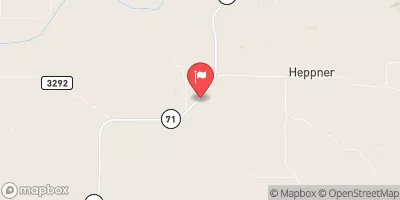Norman Dam Reservoir Report
Nearby: Whitney Dam 1 Soester Irrigation Dam
Last Updated: January 5, 2026
Norman Dam in Dawes, Nebraska, stands as a testament to human ingenuity and the symbiotic relationship between water resources and climate.
°F
°F
mph
Wind
%
Humidity
Summary
Built in 1927 for the primary purpose of irrigation, this private earth dam stretches 550 feet in length and reaches a height of 40 feet, with a storage capacity of 1503.5 acre-feet. Situated on the TR-White River, this structure is crucial for managing water flow and ensuring agricultural sustainability in the region.
Managed and regulated by the Nebraska Department of Natural Resources, Norman Dam plays a significant role in the local ecosystem by providing irrigation water for agricultural activities. With a fair condition assessment as of August 2019, the dam has been inspected regularly to ensure its structural integrity and mitigate potential hazards. Its emergency action plan, risk assessment, and inundation maps are all essential components in safeguarding the surrounding community and environment in case of unforeseen events.
As water resource and climate enthusiasts, the historical significance and engineering marvel of Norman Dam offer a compelling narrative of human intervention in shaping the landscape for sustainable development. The collaboration between private ownership, state regulation, and community engagement highlights the interconnectedness of water management and climate resilience. Norman Dam stands as a beacon of progress in balancing the needs of agriculture, environment, and society in the face of changing climatic conditions.
Year Completed |
1927 |
Dam Length |
550 |
Dam Height |
40 |
River Or Stream |
TR-WHITE RIVER |
Primary Dam Type |
Earth |
Surface Area |
78 |
Hydraulic Height |
40 |
Drainage Area |
1.17 |
Nid Storage |
1503.5 |
Structural Height |
40 |
Hazard Potential |
Significant |
Foundations |
Soil |
Nid Height |
40 |
Seasonal Comparison
Weather Forecast
Nearby Streamflow Levels
 White R Nr Ne-Sd State Line
White R Nr Ne-Sd State Line
|
10cfs |
 Horsehead Cr At Oelrichs Sd
Horsehead Cr At Oelrichs Sd
|
0cfs |
 Hat Cr Near Edgemont Sd
Hat Cr Near Edgemont Sd
|
1cfs |
 White R Near Oglala Sd
White R Near Oglala Sd
|
101cfs |
 Cheyenne R Below Angostura Dam Sd
Cheyenne R Below Angostura Dam Sd
|
2cfs |
 Fall R At Hot Springs Sd
Fall R At Hot Springs Sd
|
32cfs |
Dam Data Reference
Condition Assessment
SatisfactoryNo existing or potential dam safety deficiencies are recognized. Acceptable performance is expected under all loading conditions (static, hydrologic, seismic) in accordance with the minimum applicable state or federal regulatory criteria or tolerable risk guidelines.
Fair
No existing dam safety deficiencies are recognized for normal operating conditions. Rare or extreme hydrologic and/or seismic events may result in a dam safety deficiency. Risk may be in the range to take further action. Note: Rare or extreme event is defined by the regulatory agency based on their minimum
Poor A dam safety deficiency is recognized for normal operating conditions which may realistically occur. Remedial action is necessary. POOR may also be used when uncertainties exist as to critical analysis parameters which identify a potential dam safety deficiency. Investigations and studies are necessary.
Unsatisfactory
A dam safety deficiency is recognized that requires immediate or emergency remedial action for problem resolution.
Not Rated
The dam has not been inspected, is not under state or federal jurisdiction, or has been inspected but, for whatever reason, has not been rated.
Not Available
Dams for which the condition assessment is restricted to approved government users.
Hazard Potential Classification
HighDams assigned the high hazard potential classification are those where failure or mis-operation will probably cause loss of human life.
Significant
Dams assigned the significant hazard potential classification are those dams where failure or mis-operation results in no probable loss of human life but can cause economic loss, environment damage, disruption of lifeline facilities, or impact other concerns. Significant hazard potential classification dams are often located in predominantly rural or agricultural areas but could be in areas with population and significant infrastructure.
Low
Dams assigned the low hazard potential classification are those where failure or mis-operation results in no probable loss of human life and low economic and/or environmental losses. Losses are principally limited to the owner's property.
Undetermined
Dams for which a downstream hazard potential has not been designated or is not provided.
Not Available
Dams for which the downstream hazard potential is restricted to approved government users.
Area Campgrounds
| Location | Reservations | Toilets |
|---|---|---|
 Roberts Tract Campground
Roberts Tract Campground
|
||
 Crawford City Park
Crawford City Park
|
||
 Chadron State Park
Chadron State Park
|
||
 Red Cloud
Red Cloud
|

 Norman Dam
Norman Dam